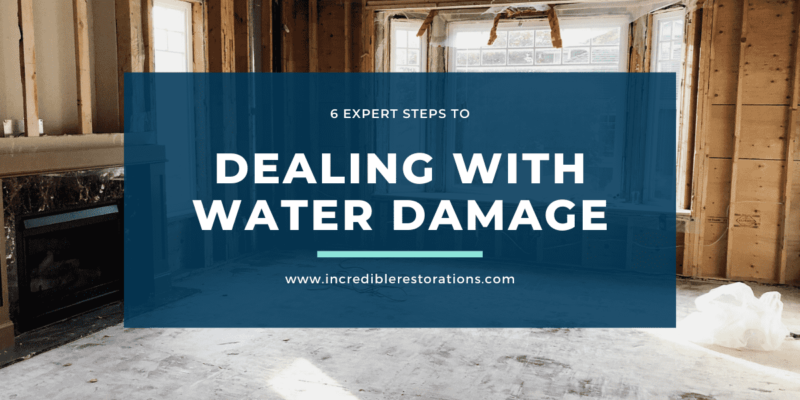If you experience a flood in your home or basement in Vancouver, Burnaby, Coquitlam, Richmond, Surrey, Langley or Abbotsford, you might be thinking…
“My home has flooded and experienced water damage, what do I do?”
What if I told you I could give you a checklist of things to do to mitigate water damage in your home?
Rainy weather in Vancouver might be making you concerned about the possibility of a flood or leak in your home.
Keep in mind that being aware of the risks and possible sources of water damage can be crucial to preventing a flood in your home.
By following these tips, you’ll know exactly what to do during a flood in your home.
So what do we mean by flooding? Well, the word flooding is loosely interchanged with water damage, and really what it refers to is any kind of water that has leaked, spilled, or intruded into your home and thus causing damage.
Anything from a leaking roof, toilet overflow, broken water pipe, excess water from rain, water appearing on your drywall, wet flooring, or a drainage problem causing your bathroom, kitchen, basement, or anywhere in your home to flood are examples of water damage.
So, if you happen to find yourself in this situation here are our 6 expert tips for dealing with a flood or water damage in your home.
6 Expert Tips
For Dealing With A
Flooded House:
1. ATTEMPT TO STOP THE WATER
In situations where the water is leaking or coming in from an obvious/accessible area then try and stop the leak ASAP.
Find the source of the leak or flood and stop what you can.
This includes overflowing toilets, appliance leaks, supply lines, outside water entering your home, and more. Find out where your supply line shut-offs are before you experience a flood, and teach your kids too.
By saving time looking for the water shut-offs you can prevent any further water damage to your home.
Obviously, there will be situations that are out of your technical skill such as repairing a leaky pipe, burst pipe, or even drain back-ups.
However,
By stopping any extra water damage from occurring, you’ll be able to save yourself more work in the future. If you find the source, make sure you do what you can to stop the excess water.
2. TURN OFF POWER TO AFFECTED AREAS
Turning off the power to flooded areas in your home prevent hazards for you and contractors.
If your dining room ceiling is leaking from the heavy rainstorm going on outside and water is dripping down your chandelier, then turn the power off to that part of your home.
This will limit the chances for electrical issues to occur, on that same note avoid using any electrical items such as vacuums as an electric shock is a possibility when standing on wet areas.
3. CLEAN UP WHAT YOU CAN
When it comes to standing water, everyone’s first thought is always grabbing all the towels in your house and soaking up all the water you can. This works great for clean water such as spills, sink overflows, or shower overflows.
However,
A quick word of caution in this step, be aware that depending on where the water came from (categories of water) it could be contaminated.
Sewage water, for example, can cause illness to a person if ingested or exposed to open cuts and sores.
See our article on safety gear you should be wearing in cases such as this.
Also, if you find yourself in a situation where there is more water than you can handle, (ie. a foot of water in your basement) calling the professionals is the best move.
4. MOVE YOUR STUFF
Do the best you can to move everything out of the wet areas.
This includes clothing, electronics, furniture, and area rugs, etc. Moving your stuff out of the way will limit the chances of it getting water damaged, but it will also prevent secondary damage such as wood and rust stains on your carpet.
Moving your belongings can also streamline the restoration process for the professionals once they arrive.
This can help the restoration team focus on the more pressing issues.
5. CALL THE PROFESSIONALS
Now you have done everything you can possibly do to limit further damages in your home, at this point you will want to call in your local restoration company to take over.
Professional restoration companies will have the manpower, expertise, and equipment necessary to properly restore your home to its pre-loss condition.
Using specialized equipment such as moisture detecting equipment, air movers, dehumidifiers, and HEPA air scrubbers, they can ensure there is no moisture left in your home.
They will also apply antimicrobial solution throughout your property in order to neutralize any contaminants as well as prevent microbial growth.
6. CALL YOUR INSURANCE COMPANY
The last step once the situation is under control and damages have been mitigated is for you to call your insurance company to inform them of the water damage loss in your home.
The reason this step is last is that if you call them earlier on you could be wasting valuable time on-hold, dealing with an agent and giving them your policy number or wasting too much time.
Instead of helping prevent further damage to your home and contents.
THERE YOU HAVE IT!
These are the 6 expert tips for dealing with water damage in your home, from a water damage restoration professional. At the end of the day remember that your health and property value are going to be at the top of your priority list. You want to make sure that your property is restored to its pre-loss condition, clean and safe of any contaminants, as well as restored with quality workmanship as it will directly affect your property’s value.
Serving Vancouver residents since 1993, Incredible Restorations offers a complete suite of property restoration and cleanup services from flood, water, fire, smoke, wind, and storm.

